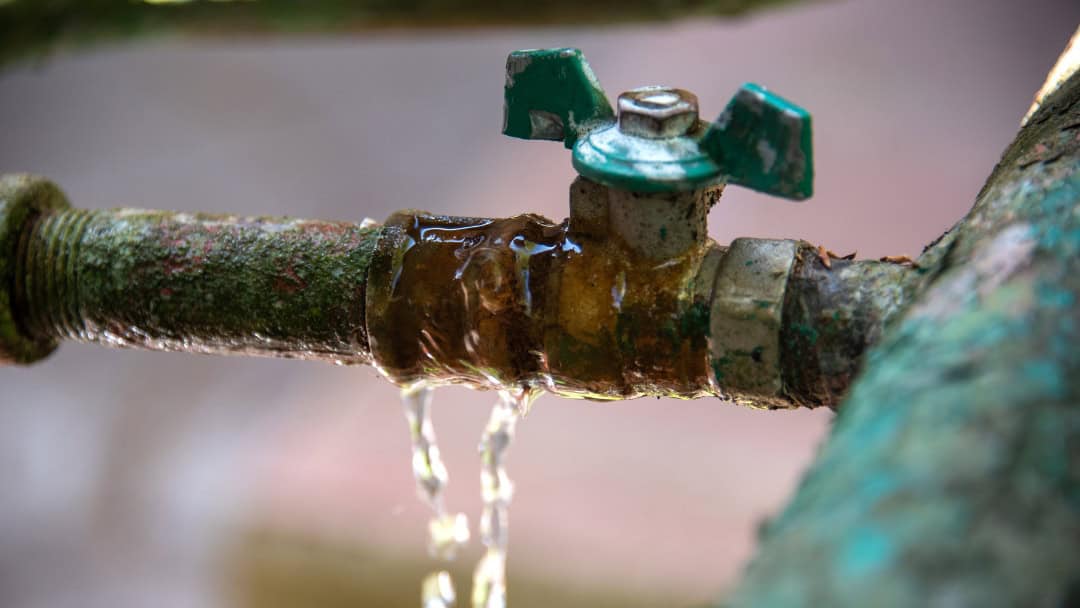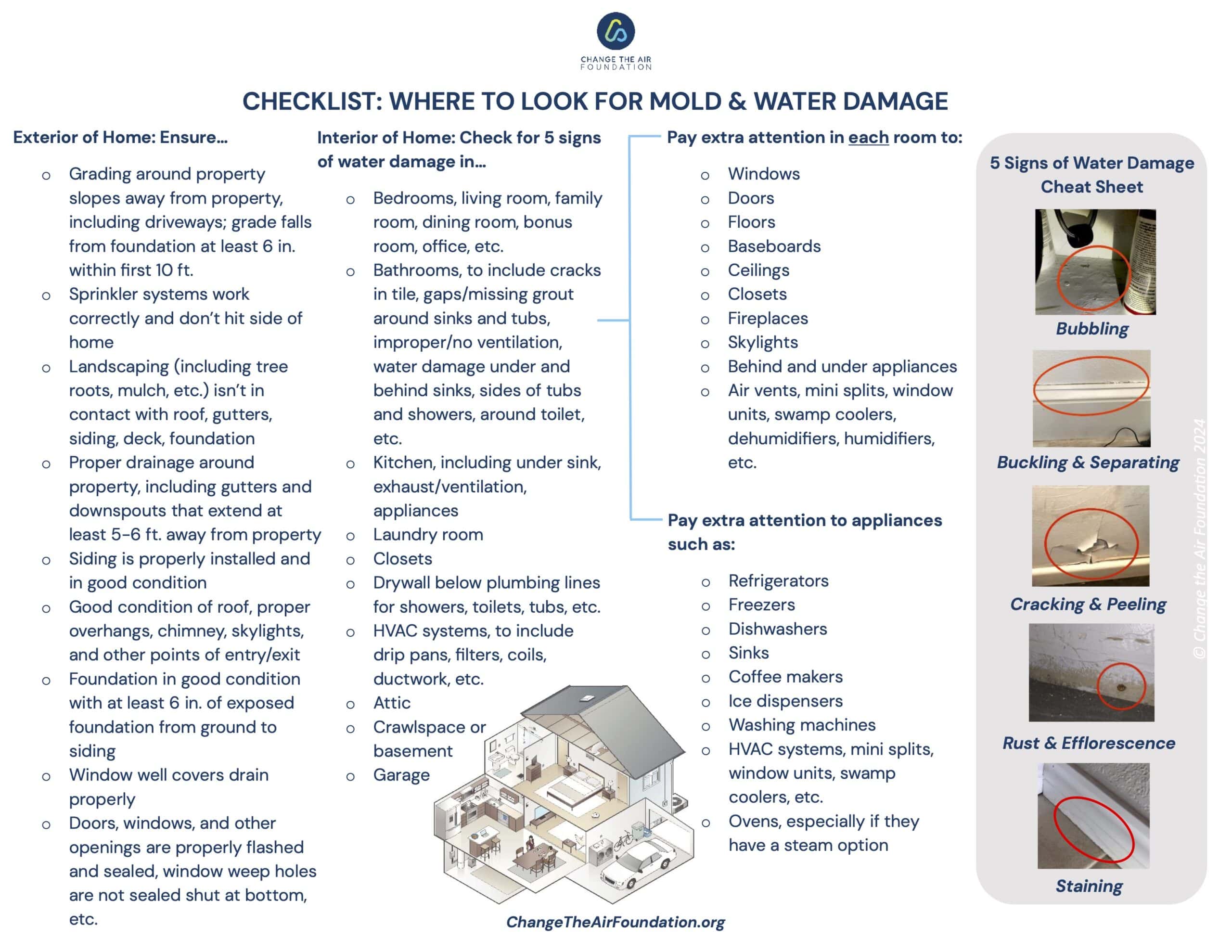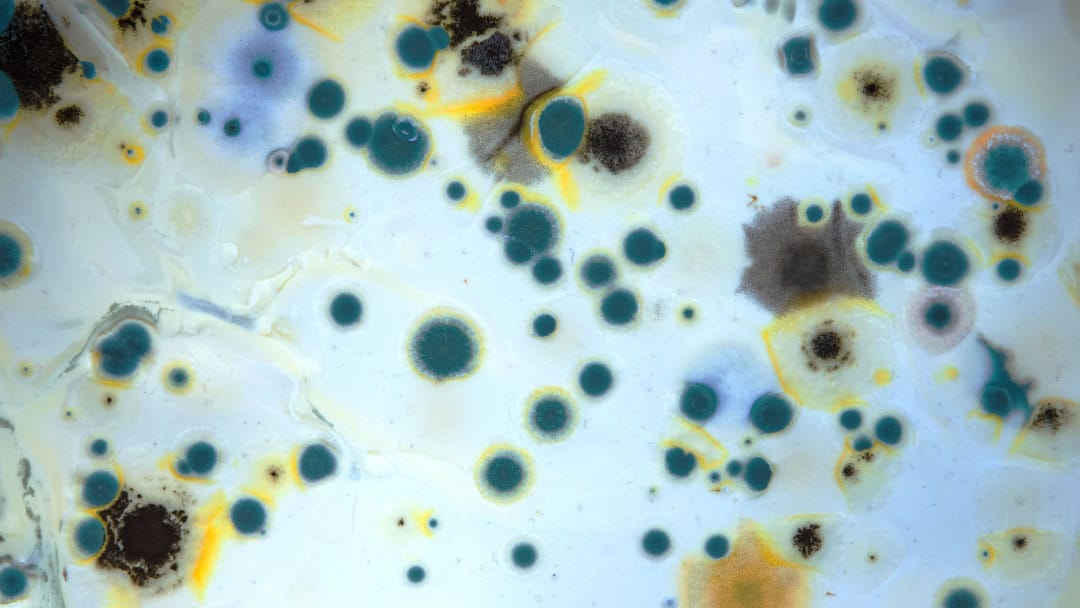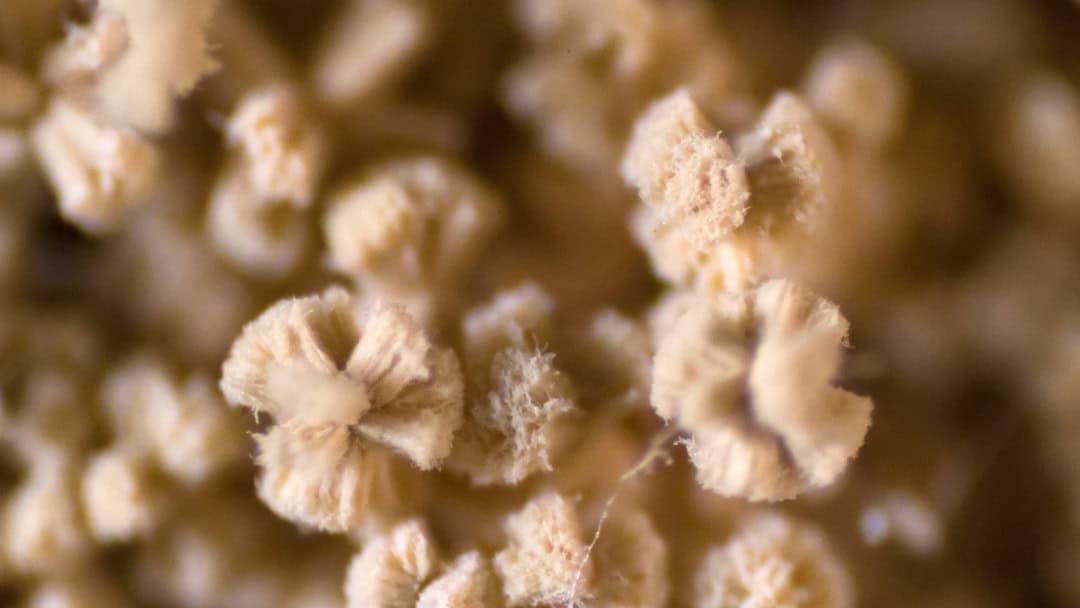Identifying mold and water damage in your home is a key to creating a healthy home environment for those with chronic health conditions. Mold, a common byproduct of moisture intrusion, can impact indoor air quality and, over time, contribute to significant health challenges.
In our experience, those who have done almost everything to improve their child’s health yet still have major symptoms often have hidden mold or water damage in their home or school. You can learn more about mold, mycotoxin and biotoxin illness here.
Understanding Mold and Moisture
Mold requires moisture to grow, and it can come from a variety of sources, such as leaks, flooding, high humidity, or inadequate ventilation. We recommend that you focus on the moisture, not just the presence of mold itself. With this in mind, you’ll want to have regular inspections and maintenance of potential moisture sources in your home.
Review This Graphic from the Change the Air Foundation
The Change the Air Foundation has helpful downloads that you can use to to empower yourself to tackle indoor air quality challenges safely and effectively. We are publishing the graphic below with their permission.
Basements and Crawl Spaces
Basements and crawl spaces are high on the list of likely areas to harbor mold. These spaces often have less air circulation and can accumulate moisture due to their proximity to the ground. They may flood in heavy rain or have leaky walls or plumbing, all of which contribute to an environment conducive to mold growth. You can use a moisture meter to regularly check these areas and employing a dehumidifier to manage humidity levels effectively.
Attics
Attics are another common mold hotspot. Poor insulation or ventilation can lead to trapped moisture, especially if there are roof leaks or condensation issues from below. It’s important to check for any signs of water stains, dampness, or visible mold in these areas. Ensure that your attic is properly ventilated to allow moisture to escape, which helps mitigate mold risk.
HVAC Systems
Your heating, ventilation, and air conditioning (HVAC) systems can also be a hidden source of mold. Because these systems often run through humid and unconditioned spaces (like attics or basements), they can create condensation and mold if not properly maintained. Regular professional maintenance, including cleaning and inspecting ducts and filters, is essential to prevent mold growth.
Kitchens and Bathrooms
These areas are frequent sites of water use and are prone to leaks and high humidity, making them prime environments for mold. Inspect under sinks, around toilets, and along the edges of bathtubs and showers for any leakage or water damage. Ensure that exhaust fans are functioning correctly to remove excess moisture from the air during and after showering or cooking.
Laundry Areas
Laundry rooms can create significant moisture if dryers are not properly vented to the outside or if there are leaks around washing machines. Given their routine exposure to water, these areas should be regularly checked for leaks and moisture buildup. Installing a drip pan under your washing machine and using a dehumidifier can help control the environment.
The Importance of Proper Ventilation
Proper ventilation throughout the home is important to preventing mold growth. Make sure that all exhaust fans are venting to the outside and not into another part of the home, such as the attic. Additionally, opening windows periodically to improve airflow can help reduce indoor humidity levels on dry days.
Exterior Considerations
The exterior of your home can also contribute to mold problems inside. Poor drainage, faulty gutters, and improper grading can lead to water pooling around the foundation, increasing the risk of leaks and subsequent mold growth indoors. Regularly inspect and maintain the exterior drainage systems and ensure that water flows away from the home.
Early Detection Tools
As part of a proactive approach, utilizing tools such as moisture meters, humidity gauges, and self-testing kits for mold can be highly beneficial. Conduct regular checks in the spring and fall when weather changes can often reveal new leaks or moisture issues.
About Maria Rickert Hong CHHC
Maria Rickert Hong is a Co-Founder of, and the Education and Media Director for, Documenting Hope.
She is a former sell-side Wall Street equity research analyst who covered the oil services sector at Salomon Smith Barney and Lehman Brothers under Institutional Investor #1 ranked analysts.
Later, she covered the gaming, lodging & leisure sector at Jefferies & Co. and Calyon Securities. She quit working on Wall Street when her first son was born.

Prior to working on Wall Street, she was a marketing specialist for Halliburton in New Orleans, where she also received her MBA in Finance & Strategy from Tulane University.
She is the author of the bestselling book Almost Autism: Recovering Children from Sensory Processing Disorder and the co-author of Brain Under Attack: A Resource for Parents and Caregivers of Children with PANS, PANDAS, and Autoimmune Encephalitis. She is a co-author of Reversal of Autism Symptoms among Dizygotic Twins through a Personalized Lifestyle and Environmental Modification Approach: A Case Report and Review of the Literature, J. Pers. Med. 2024, 14(6), 641.
Maria is also a Certified Holistic Health Counselor. Her work can be found on DocumentingHope.com, Healing.DocumentingHope.com, Conference.DocumentingHope.com and MariaRickertHong.com
Still Looking for Answers?
Visit the Documenting Hope Practitioner Directory to find a practitioner near you.
Join us inside our online membership community for parents, Healing Together, where you’ll find even more healing resources, expert guidance, and a community to support you every step of your child’s healing journey.
Sources & References
Baker, S., et al. Case Study: Rapid Complete Recovery From An Autism Spectrum Disorder After Treatment of Aspergillus With The Antifungal Drugs Itraconazole And Sporanox. Integr Med (Encenitas). 2020 Aug;19(4):20-27.
Bennett, J.W., et al. Mycotoxins. Clinical Microbiology Reviews. Jul 2003: 497-516.
Berndtson, K., et al. Medically sound investigation and remediation of water-damaged buildings in cases of CIRS-WDB. Center for Research on Biotoxin Associated Illness. 2016 Jan 19.
Berry, Y. A Physician’s Guide to Understanding and Treating Biotoxin Illness. 2014.
de Allori, M.C.G., et al. Antimicrobial resistance and production of biofilms in clinical isolates of coagulase-negative Staphylococcus strains. Biol Pharm Bull. 2006 Aug;29(8):1592-6.
De Santis, B., et al. Role of mycotoxins in the pathobiology of autism: A first evidence. Nutr Neurosci. 2019 Feb;22(2):132-144.
De Santis, B., et al. Study on the Association among Mycotoxins and other Variables in Children with Autism. Toxins (Basel). 2017 Jun 29;9(7):203.
Hope, J. A review of the mechanism of injury and treatment approaches for illness resulting from exposure to water-damaged buildings, mold, and mycotoxins. ScientificWorldJournal. 2013 Apr 18;2013:767482.
Hudnell, H.K. Chronic biotoxin-associated illness: multiple-system symptoms, a vision deficit, and effective treatment. Neurotoxicol Teratol. Sep-Oct 2005;27(5):733-43.
Institute of Medicine (US) Committee on Damp Indoor Spaces and Health. Damp Indoor Spaces and Health. Washington (DC): National Academies Press (US); 2004.
Kali, A. Antibiotics and bioactive natural products in treatment of methicillin resistant Staphylococcus aureus: A brief review. Pharmacogn Rev. Jan-Jun 2015;9(17):29-34.
Kontoyiannis, D.P., et al. Treatment principles for the management of mold infections. Cold Spring Harb Perspect Med. 2014 Nov 6;5(4):a019737.
Oliva, A., et al. High Potency of Melaleuca alternifolia Essential Oil against Multi-Drug Resistant Gram-Negative Bacteria and Methicillin-Resistant Staphylococcus aureus. Molecules. 2018 Oct 9;23(10):2584.
Ratnaseelen, A.M., et al. Effects of Mycotoxins on Neuropsychiatric Symptoms and Immune Processes. Clin Ther. 2018 Jun;40(6):903-917.
Salari, M.H., et al. Antibacterial effects of Eucalyptus globulus leaf extract on pathogenic bacteria isolated from specimens of patients with respiratory tract disorders. Clin Microbiol Infect. 2006 Feb;12(2):194-6.
Shoemaker, R.C., et al. Sick building syndrome (SBS) and exposure to water-damaged buildings: time series study, clinical trial and mechanisms. Neurotoxicol Teratol. Sep-Oct 2006;28(5):573-88.
Shoemaker, R.C., et al. Structural brain abnormalities in patients with inflammatory illness acquired following exposure to water-damaged buildings: a volumetric MRI study using NeuroQuant®. Neurotoxicol Teratol. Sep-Oct 2014;45:18-26.
Shoemaker, R.C., et al. A time-series study of sick building syndrome: chronic, biotoxin-associated illness from exposure to water-damaged buildings. Neurotoxicol Teratol. Jan-Feb 2005;27(1):29-46.
Resources
Articles
Dr. Bogner Health: Mycotoxins and Autism
Dr. Shoemaker’s 11 Step Treatment Protocol
Books
Dashore, Jodie. The BioNexus Approach to Biotoxin Illness. Blurb, 2020.
Shoemaker, Ritchie MD, et al. The Art and Science of CIRS Medicine. BookBaby, 2020.
Shoemaker, Ritchie MD, et al. Surviving Mold: Life in the Era of Dangerous Buildings. Otter Bay Books, 2010.
Vetter, Paula. Mold Illness: Surviving and Thriving: A Recovery Manual for Patients & Families Impacted By CIRS. BookBaby, 2018.
Presentations
Berry, Yvonne. A Physician’s Guide to Understanding & Treating Biotoxin Illness. Based on the work of Ritchie Shoemaker, M.D.
Tests
GENIE (Genomic Expression: Inflammation Explained) test
Mosaic Diagnostics MycoTOX Profile
Visual Contrast Sensitivity Test (VCS)
Websites
Change the Air Foundation's Downloads on Mold Remediation
Videos
Autism and Mold Exposure: Why Testing for Mycotoxins is so Important by Dr. Woeller








